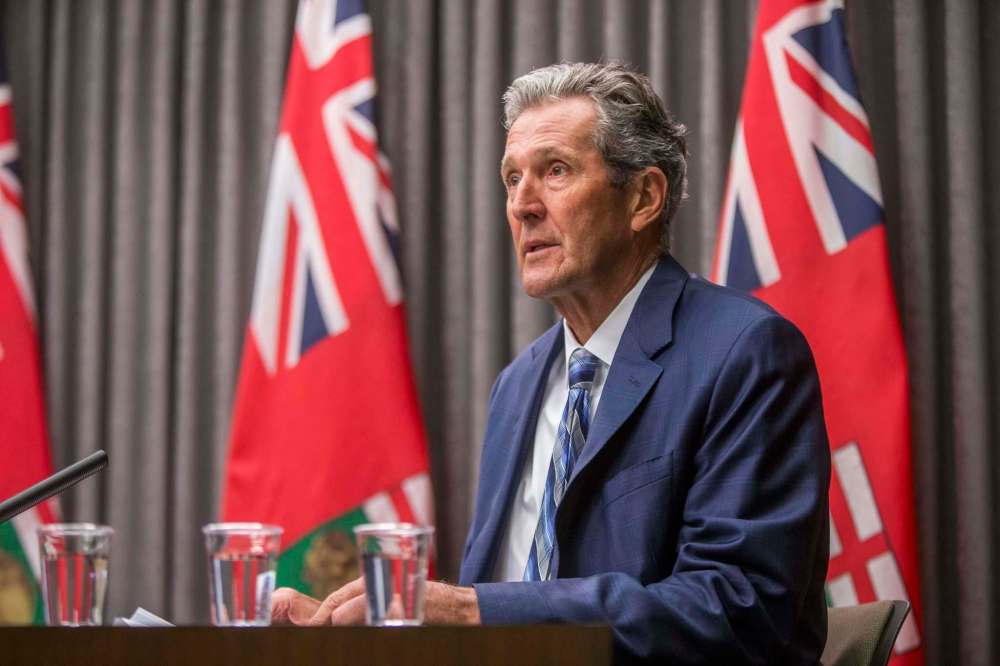Pallister should look Down Under, where 26 cases results in lockdown
Read this article for free:
or
Already have an account? Log in here »
To continue reading, please subscribe:
Monthly Digital Subscription
$0 for the first 4 weeks*
- Enjoy unlimited reading on winnipegfreepress.com
- Read the E-Edition, our digital replica newspaper
- Access News Break, our award-winning app
- Play interactive puzzles
*No charge for 4 weeks then price increases to the regular rate of $19.00 plus GST every four weeks. Offer available to new and qualified returning subscribers only. Cancel any time.
Monthly Digital Subscription
$4.75/week*
- Enjoy unlimited reading on winnipegfreepress.com
- Read the E-Edition, our digital replica newspaper
- Access News Break, our award-winning app
- Play interactive puzzles
*Billed as $19 plus GST every four weeks. Cancel any time.
To continue reading, please subscribe:
Add Free Press access to your Brandon Sun subscription for only an additional
$1 for the first 4 weeks*
*Your next subscription payment will increase by $1.00 and you will be charged $16.99 plus GST for four weeks. After four weeks, your payment will increase to $23.99 plus GST every four weeks.
Read unlimited articles for free today:
or
Already have an account? Log in here »
Hey there, time traveller!
This article was published 27/05/2021 (1659 days ago), so information in it may no longer be current.
One day, two different jurisdictions, and two significantly different approaches to combatting COVID-19.
In Australia, the state of Victoria — the country’s second-largest and home to its second-largest city, Melbourne — implemented a total “circuit-breaker” lockdown Thursday morning after identifying just 26 new cases of community transmission involving the B.1.617 variant.
Melbourne, Australia, set for 4th lockdown as cluster grows

Posted:
CANBERRA, Australia (AP) — Australia’s second-largest city was set to enter its fourth lockdown Thursday as concern grew over the rapid spread of infections from a coronavirus variant.
The seven-day lockdown is comprehensive: everyone must wear masks any time they’re outside their homes; all non-essential businesses are closed; residents can only shop for essentials within five kilometres of their home; all indoor and outdoor social gatherings are prohibited; all bars and restaurants are closed; all public spaces, including malls, non-essential retail, theatres, sporting venues and casinos are closed; no travel is allowed out of or within the state; incoming travellers must do a mandatory 14-day, supervised quarantine.
Meanwhile, back in Manitoba, Premier Brian Pallister announced that even in the face of the worst outbreak in North America, he was once again going to take a “nuanced” approach.
Pallister argued strenuously he was introducing new, stronger restrictions. The reality is that on a day in which eight more deaths were reported (including a 30-year-old woman), the premier announced something that was mostly a regurgitation of restrictions already in place.
Pallister and chief provincial public health officer Dr. Brent Roussin did repeatedly plead with Manitobans to stay home. However, the premier refused to issue a full stay-at-home order and decided non-essential retail businesses, including malls, could remain open.
Employers were strongly encouraged to allow their employees to work from home whenever possible. But Pallister stopped short of closing all non-essential workplaces. There were no additional restrictions on travel within or outside the province.
At a time when Manitoba needed decisive action, we got the same old pig with a whole new coat of lipstick.
Consider the lunacy of what Pallister and Roussin announced Thursday.
By allowing all retail stores to remain open, Pallister and Roussin are creating an opportunity for us to engage in the type of trip out of the house that they both said we should not take.
While pleading with people to stay at home, current restrictions allow people to continue going out to work in non-essential offices, warehouses or factories.
By allowing all retail stores to remain open, Pallister and Roussin are creating an opportunity for us to engage in the type of trip out of the house that they both said we should not take.
It is not a little bit ironic that Pallister’s latest dithering came on the same day that Australia was showing the world how it should be done.
Even though Victoria had implemented a lockdown in February and had early success in containing COVID-19, the state was walloped by a catastrophic second wave last summer and into the fall. Victoria locked everything down for an unfathomable 112 days.
When it was over, Victoria had suffered more than 20,000 infections and 820 deaths.
By late October, however, there were so few active cases that restrictions could be eased. Since then, Victorians have lived a mostly normal lifestyle; bars, restaurants, sporting and cultural events have all been open with only a few modest limits.
Victoria is demonstrating the most important principle of an effective pandemic response: short, sharp lockdowns triggered at the first sign of a resurgence.
And then, over the past week, about two dozen cases of a wildly contagious COVID-19 variant were discovered. Victoria went from almost no restrictions to a total lockdown.
In taking this action, Victoria is demonstrating the most important principle of an effective pandemic response: short, sharp lockdowns triggered at the first sign of a resurgence. For reasons that are not clear, it is the one principle that continues to evade the Pallister government.
Pallister insists on an approach in which social and economic restrictions are increased very slowly to match increases in the number of new cases. He seems oblivious to the fact that iterative increases in restrictions only prolong the period of partial lockdown and do little to stem the tide of new cases.
Although Victoria’s July-to-October lockdown was long and severe, its citizens ultimately enjoyed more than seven months of normal life afterwards, something that Manitobans have rarely enjoyed over the past year. Having had success with the first total lockdown, Victoria officials are confident they will only need a week of severe restrictions to bring this latest outbreak to a halt.
On Thursday, Pallister was asked bluntly whether he should have implemented a much harder lockdown, much earlier in this third wave. The premier swatted the suggestion away like a spring mosquito.

Pallister argued that implementing a total lockdown when Manitoba was recording about 100 new cases per day — as many physicians and scientists demanded earlier this year — would have been too unpopular to be effective.
“How do you imagine the public would have been affected by introducing public health rules when we had fewer than 100 cases (per day), that restricted all non-essential retail?” Pallister said. “Do you think we would have got buy-in from the public?”
The premier ought to know by now that a significant portion of the public has figured out his current pandemic strategy is a hot, woeful mess. We need only look at opinion polls that have the premier and his party plummeting in popularity.
More importantly, Pallister and his public health officials should have learned from other jurisdictions that short, sharp lockdowns result in less disease and fewer deaths, while ultimately allowing for much longer periods of unrestricted living.
The premier needs to spend less time worrying about what is popular, and start focusing on strategies to get us out of this mess.
dan.lett@freepress.mb.ca

Born and raised in and around Toronto, Dan Lett came to Winnipeg in 1986, less than a year out of journalism school with a lifelong dream to be a newspaper reporter.
Our newsroom depends on a growing audience of readers to power our journalism. If you are not a paid reader, please consider becoming a subscriber.
Our newsroom depends on its audience of readers to power our journalism. Thank you for your support.
History
Updated on Thursday, May 27, 2021 7:11 PM CDT: Corrects grammatical error.










